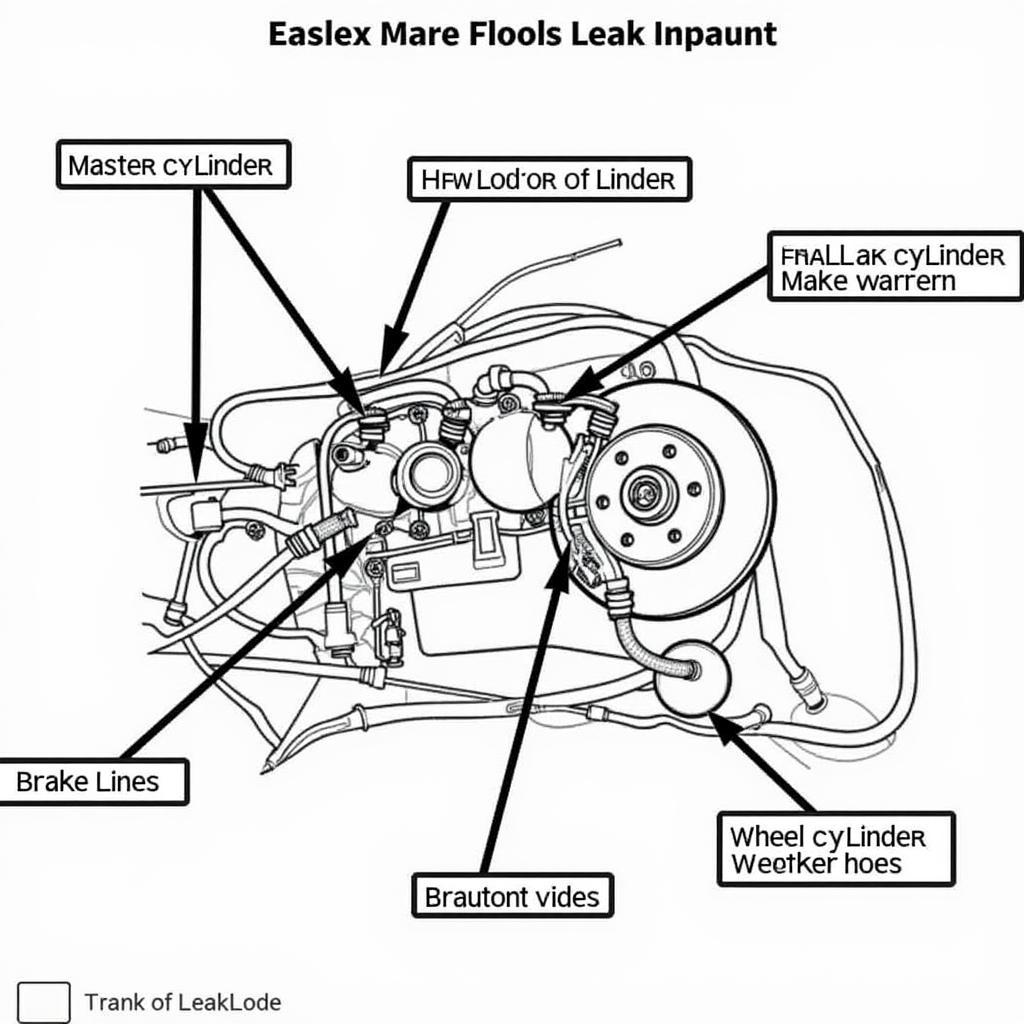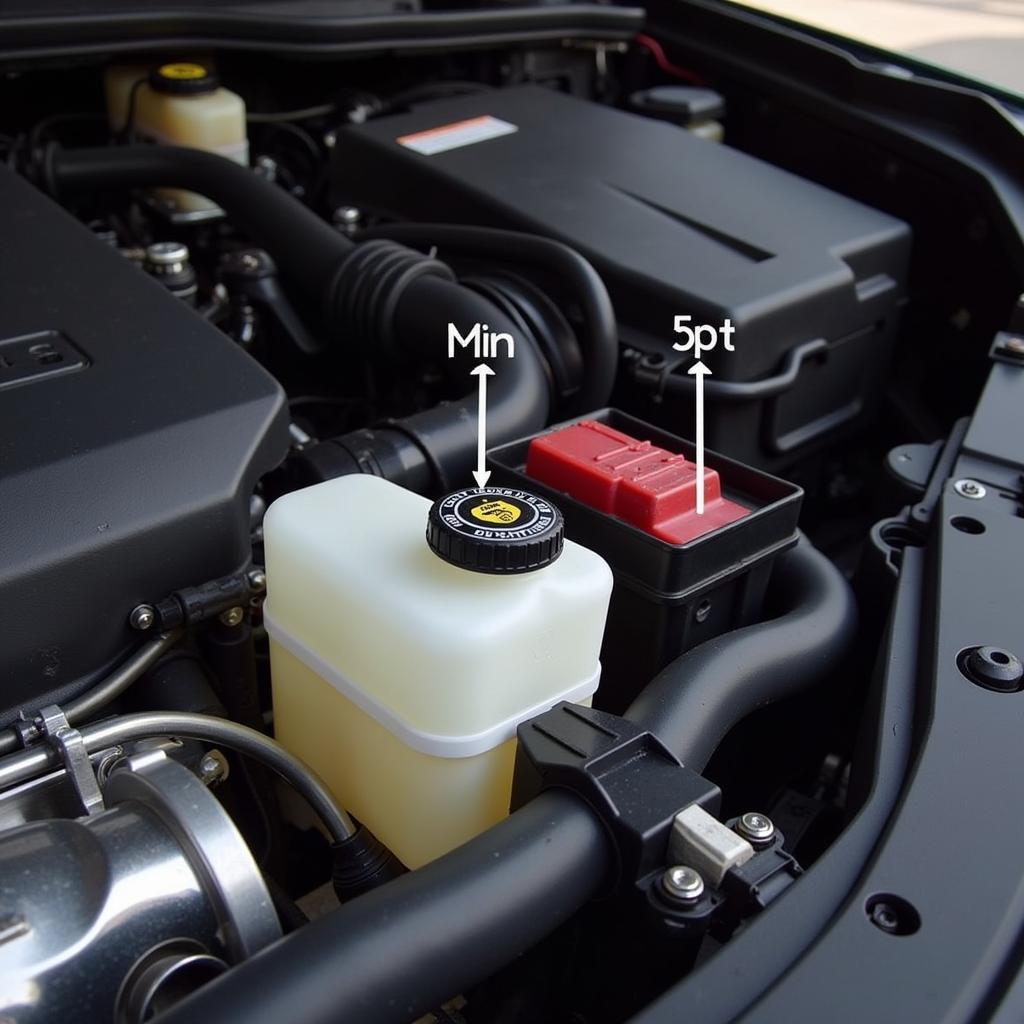A low brake fluid warning light illuminating on your 2003 Chevy Impala dashboard is a serious concern that should never be ignored. This warning indicates a potential leak in your brake system, which could lead to reduced braking ability and ultimately, a dangerous situation. Let’s delve into the common causes, troubleshooting steps, and solutions for addressing low brake fluid in your Impala.
Understanding the Warning Sign: Why is My Brake Fluid Low?
Before we dive into solutions, it’s crucial to understand why your brake fluid might be low in the first place. The brake system in your Impala, like in all vehicles, is a closed hydraulic system. This means that fluid is responsible for transmitting the force from your foot on the brake pedal to the brake calipers, which then squeeze the brake pads, bringing your vehicle to a stop.
When the brake fluid level drops, it signifies a loss of pressure within this system. This pressure loss can significantly compromise your car’s braking power, making it difficult to stop effectively.
Here are the most common culprits behind low brake fluid in a 2003 Chevy Impala:
- Brake Fluid Leak: This is the most common reason. Leaks can occur in various parts of the brake system, including the master cylinder, brake lines, brake hoses, and wheel cylinders.
- Worn Brake Pads: Over time, brake pads naturally wear down. As they thin, the brake calipers need to push out further to apply the brakes, requiring more brake fluid. While worn brake pads alone won’t typically trigger the low fluid warning, if you’ve been driving with worn pads for a while, the fluid level may drop enough to turn on the light.
- Internal Leak in the Master Cylinder: The master cylinder is a vital component of your brake system, and an internal leak within it can cause a drop in brake fluid level without any visible external leaks.
 2003 Chevy Impala Brake Fluid Leak Locations
2003 Chevy Impala Brake Fluid Leak Locations
Troubleshooting the “Low Brake Fluid Warning Light Tight” Message
If you’re seeing the low brake fluid warning and the message “tight,” it’s essential to address the issue immediately. This message adds another layer to the problem, suggesting a possible issue with the parking brake system or a sensor malfunction. Here’s a systematic approach to troubleshooting:
-
Check the Brake Fluid Level:
- Park your car on a level surface.
- Locate the brake fluid reservoir under the hood. It’s usually a translucent plastic container with a black cap labeled “Brake Fluid.”
- Visually inspect the fluid level. It should be between the “Min” and “Max” lines.
-
Inspect for Visible Leaks:
- If the fluid level is low, carefully examine the area around the master cylinder, brake lines, and near the wheels for any signs of fluid leaks. Brake fluid is typically clear to light brown and has a slightly oily texture.
-
Check the Parking Brake:
- Make sure the parking brake is fully released. Sometimes, if the parking brake is not completely disengaged, it can cause the “tight” message to appear.
-
Consider Sensor Malfunction:
- While less common, it’s possible that a faulty brake fluid level sensor is triggering the warning light even if the fluid level is adequate.
Seeking Professional Diagnostics and Repair: Remote Software Solutions
If you’re uncomfortable performing these checks yourself, or if you suspect a more complex issue like a master cylinder problem or sensor malfunction, it’s time to bring in the experts.
This is where remote diagnostics and software solutions come in. Modern automotive technology allows skilled technicians to remotely access your vehicle’s computer system to diagnose the root cause of the low brake fluid warning and the “tight” message.
Here’s how it works:
- Connect and Diagnose: You’ll connect your vehicle to a diagnostic tool and share the data with a remote technician.
- Pinpoint the Issue: The technician can analyze the data in real-time, identifying the source of the problem, whether it’s a leak, sensor issue, or electronic fault within the braking system.
- Software Solutions: In many cases, the technician can use specialized software to recalibrate sensors, clear fault codes, or even perform software updates remotely – potentially resolving the issue without the need for immediate physical repair.
A Quote from the Expert:
“Remote diagnostics are revolutionizing car repair. In situations like a low brake fluid warning, we can often quickly pinpoint the problem and even perform software-based fixes remotely. This saves car owners valuable time and money, and in many cases, can provide a faster solution than traditional methods.” – [Expert Name, Credentials, and Company]
Conclusion: Addressing Low Brake Fluid is Critical
A low brake fluid warning light on your 2003 Chevy Impala is a safety concern that demands prompt attention. While simple fixes like topping off the fluid or replacing worn brake pads may be possible, it’s crucial to properly diagnose the root cause to ensure a safe and reliable driving experience. Remote diagnostics and software solutions offer a cutting-edge approach to quickly identify and address the problem, often providing faster and more efficient solutions. Remember, never compromise when it comes to your safety on the road.


